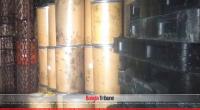 The 2009 Peelkhana carnage was a well orchestrated plot by anti-liberation elements in an attempt to destabilise the country by ousting the then-newly installed Awami League government, say security analysts.
The 2009 Peelkhana carnage was a well orchestrated plot by anti-liberation elements in an attempt to destabilise the country by ousting the then-newly installed Awami League government, say security analysts.
“The conspirators’ objective was to oust the newly formed government,” retired Bangladesh Army Major General Mohammad Ali Sikder said as security analysts and observers rallied at a discussion at the National Press Club coinciding with the anniversary of the carnage 10 years ago, reports BSS.
He added the plotters mobilized the soldiers to stage the so-called mutiny in the then Bangladesh Rifles (BDR) clearly to create “an anarchy and civil war in the country” as they simultaneously tried to spearhead misleading propaganda as the mutiny was underway.
Sikder said mutineer BDR soldiers at Peelkhana were equipped with heavy weapons like mortars, heavy machine guns, light machine guns, grenades and they could have resisted and could have retaliated military counterattacks causing further bloodshed.
“The Peelkhana mutiny had exposed the new government to an acid test which it overcame successfully,” he said.
The speakers said the plotters design eventually was upset particularly due to Prime Minister Sheikh Hasina’s firm decision, wisdom and patience which drew to an end to the mutiny within 36 hours though it had claimed 74 lives, 57 of them being brilliant military officers.
Retired Major Gen Abdur Rashid agreed with Shikdar saying Awami League’s election to power caused anti-liberation forces heartburn, which led them to hatch the mutiny plot.
He said the plotters made all out efforts to mislead the nation throwing into air false information constantly in those hours.
“The decision of the then Awami League government over the Peelkhana issue at that crucial time was very practical and democratic,” he said.
Sheikh Hasina’s handling of the situation with wisdom, patience and intelligence also drew global communities appreciation.
A senior journalist at that time, former Jatiya Ptress Club president and incumbent Awami League lawmaker Shafiqur Rahman joined the discussion as a special speaker.
Former secretary Nasir Uddin Ahmed, renowned cultural personality Pijush Bandyopadhyay and veteran hockey player Faisal Ahsanullah also spoke, among others, at the function titled “publicity-propaganda on Peelkhana carnage” organized by Bangladesh Online Activist Forum (BOAF).
BOAF President Kabir Chowdhury Tonmoy chaired the function while Jagannath University Prof Dr Milton Biswas made the key-note presentation.
Shafiqur Rahman said the BDR carnage plotters used the propaganda techniques of anti-liberation forces in 1971 and Bangabandhu killers in 1975.
“Their aim was total cleansing of the pro-liberation forces and the freedom fighters,” he said.
The journalist-turned-politician questioned why BNP chairperson Khaleda Zia left her cantonment residence in a hurry just ahead of the beginning of the mutiny on February 25, 2009.
He said investigations later revealed that Khaleda’s son Tarique Rahman phoned her before the mutiny for 45 times.
He also asserted that no matter how many conspiracies the BNP-Jamaat clique hatches, they would not be successful.
The mutiny by some members of the then Bangladesh Rifles (BDR) had started in the Pilkhana headquarters of the border guards in the capital Dhaka on Feb 25, 2009 and ended the following day.
As many as 74 people, including 57 army officers were killed. The mutiny had spread to other BDR camps across the country but no killing was reported outside Dhaka.
The incident also drew international concern. After the mutiny, BDR was renamed Border Guard Bangladesh (BGB) and its uniform changed.
Eight years later in 2017, the High Court awarded death penalties to 139 people for their roles in the country’s bloodiest mutiny. Another 185 people were sentenced to life in prison while 228 others were jailed for various terms.
 National
National
41175 hour(s) 19 minute(s) ago ;
Morning 10:13 ; Saturday ; Jun 28, 2025
‘Pilkhana carnage was an anti-liberation plot’
Send
Bangla Tribune Desk
Published : 02:00, Feb 25, 2019 | Updated : 02:00, Feb 25, 2019
Published : 02:00, Feb 25, 2019 | Updated : 02:00, Feb 25, 2019
0 ...0 ...
/zmi/
Topics: Top Stories
- KOICA donates medical supplies to BSMMU
- 5 more flights to take back British nationals to London
- Covid19: Rajarbagh, Mohammadpur worst affected
- Momen joins UN solidarity song over COVID-19 combat
- Covid-19: OIC to hold special meeting
- WFP begins food distribution in Cox’s Bazar
- WFP begins food distribution in Cox’s Bazar
- 290 return home to Australia
- Third charter flight for US citizens to return home
- Dhaka proposes to postpone D8 Summit
Unauthorized use of news, image, information, etc published by Bangla Tribune is punishable by copyright law. Appropriate legal steps will be taken by the management against any person or body that infringes those laws.
Bangla Tribune is one of the most revered online newspapers in Bangladesh, due to its reputation of neutral coverage and incisive analysis.
F R Tower, 8/C Panthapath, Shukrabad, Dhaka-1207 | Phone: 58151324; 58151326, Fax: 58151329 | Mob: 01730794527, 01730794528


